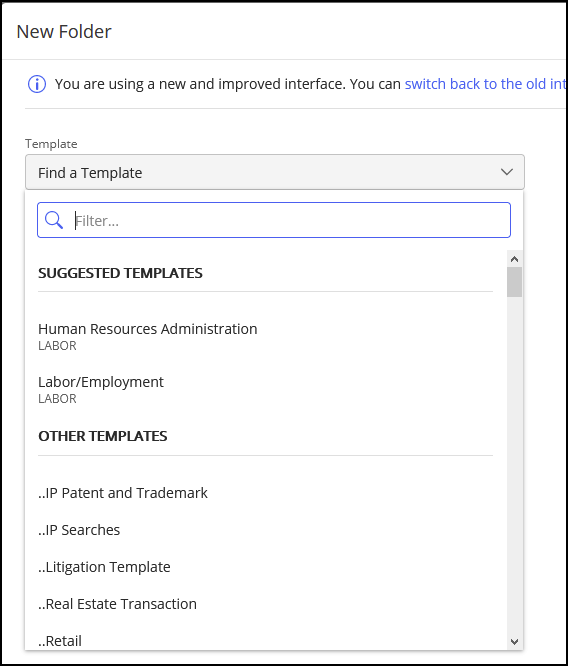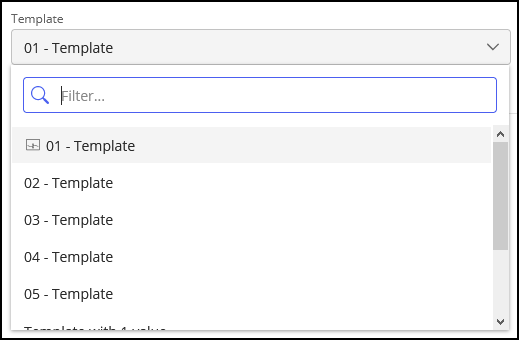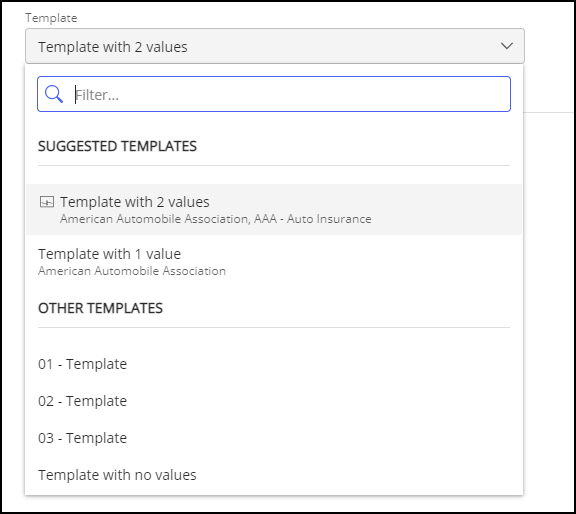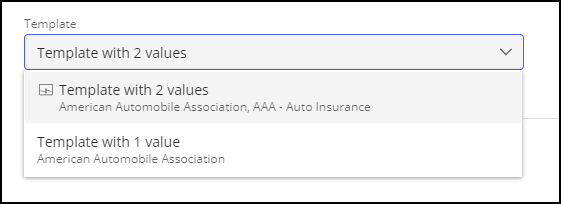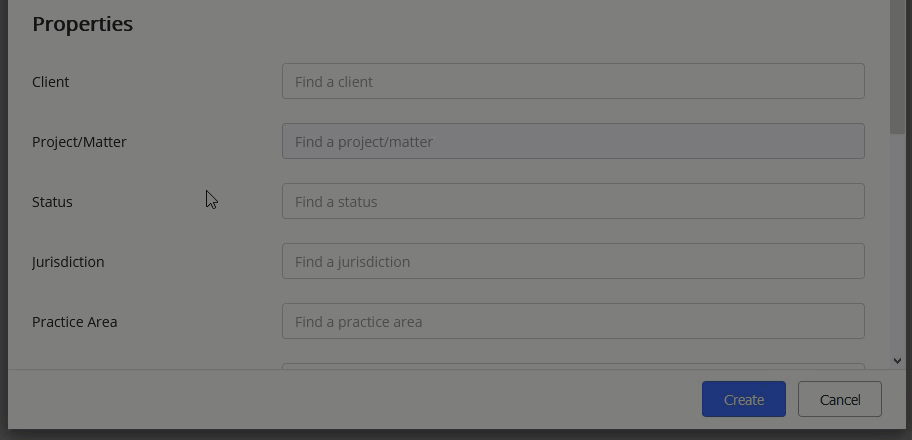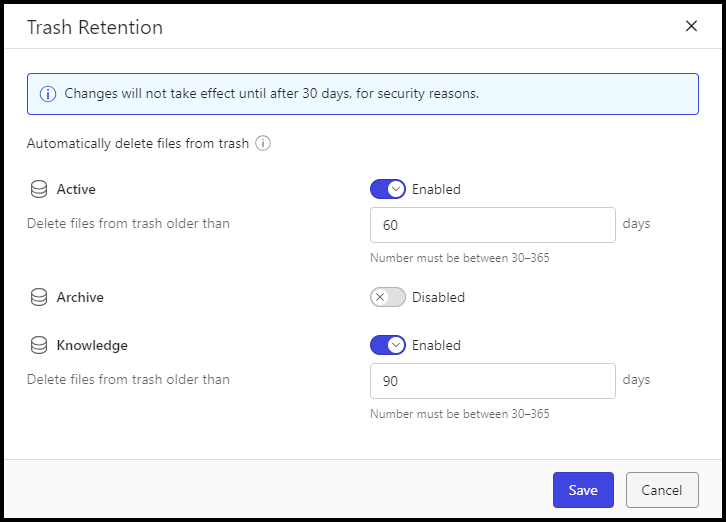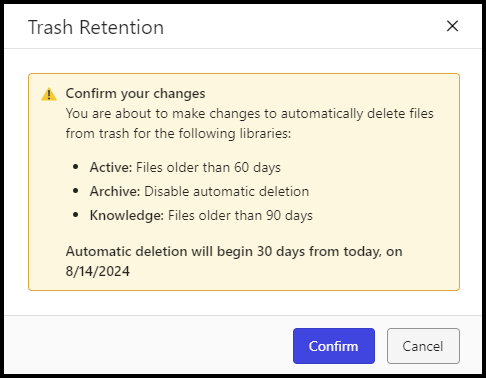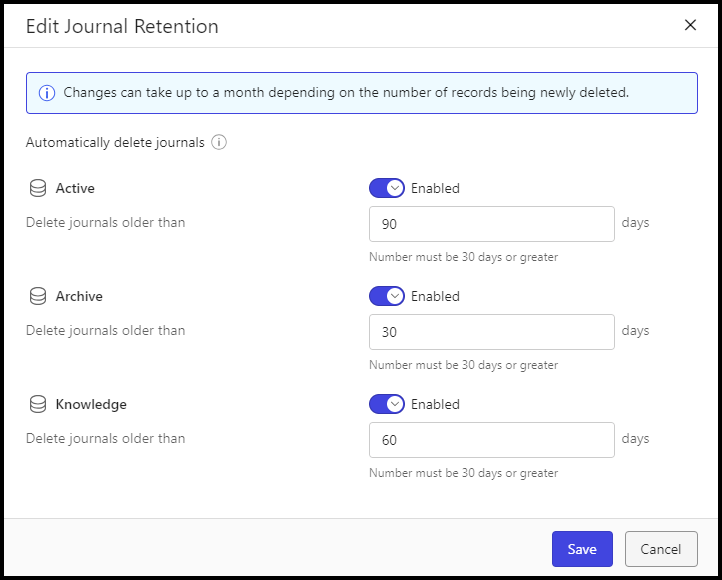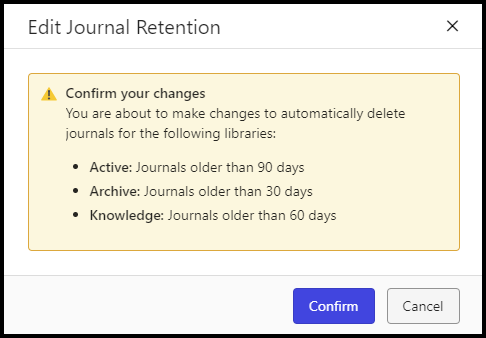This page lets you configure iManage Work global settings. When configured, these settings are applied to all iManage Work libraries.
NOTE: To perform operations on the Global page, the user signed in to iManage Control Center must be assigned to a Global role with the Setting Management privilege. For more information, refer to Global privilege descriptions.
Changes to these settings may require up to eight hours to take effect.
To view the global settings and to edit the required fields, browse to SETTINGS > Global.
Editing global settings
On the Global page, settings are organized in the following categories:
Analytics
Documents
Flexible Folders
Metadata
Trash Retention
Journal Retention
User Trash
Workspace Permissions
To update the settings for a particular category:
Locate the category and select Edit. The applicable dialog is displayed.
Modify the required fields. For more details, refer to Table: Global settings values.
Select Save.
Table: Global settings values
Name | Value | Default value | Description |
|---|---|---|---|
Analytics | |||
Enable collection of usage analytics by iManage? | Disabled Enabled | Disabled | To share usage details in the analytics collected by iManage, set Enable collection of usage analytics by iManage? to Enabled. For more information, refer to Analytics. |
Enable collection of search analytics by iManage? | Disabled Enabled | Disabled | To share search query parameters in the analytics collected by iManage, set Enable collection of search analytics by iManage? to Enabled. For more information, refer to Analytics. NOTE: The Enable collection of search analytics by iManage? option can be enabled only if the Enable collection of usage analytics by iManage? option is also enabled. |
Documents | |||
Allow edit on document versions? | Yes, all versions Yes, most recent version only No | Yes, all versions | Specifies which versions of a document users are allowed to edit, within their other security limitations. Changes include editing document content, changing default security and user's access permissions for the document, and changing properties. This setting applies to all documents across all libraries.
NRTADMINs always have Yes, all versions access regardless of the value selected. |
Flexible Folders | |||
Enable Flexible Folders? | Disabled Enabled | Enabled | Enables or disables the Flexible Folders feature, which uses predefined templates to pre-populate and enforce the container structure when a workspace is created. It also restricts creating, deleting, and renaming containers after the workspace has been created. These templates allow your company to better structure and control workspaces according to your best practices.
For more information, refer to Templates. |
NOTE: The following settings are visible only if the Flexible Folders feature is enabled. | |||
Set Match Fields to filter template searches by. | None, one, or two Metadata fields | Not selected | When Flexible Folders is enabled, specify the fields used to suggest templates to users when they create new template-based folders or tabs in iManage Work. Templates with field values that match those of the parent workspace where the folder or tab is created will be suggested at the top of the template selection menu. The following example shows the New Folder dialog, where the Practice Area field is set as a Match field. The user is creating a New Folder within a workspace which has its Practice Area set to Labor. Two templates are displayed under Suggested Templates, as these templates match this Practice Area (Labor). Figure: New Folder
Suggested templates won't be displayed to the user in either of the following scenarios:
In either scenario, all templates are displayed in alphabetical order: Figure: Template NOTE: To configure this field, you must enable the Flexible Folders feature. |
Show all available templates to user while searching? | Yes, show all templates No, show only exact match templates | Yes, show all templates | NOTE: This setting is available only if it's been enabled in your environment. For more information or to request this capability, contact your iManage Customer Success Manager. When the Flexible Folders feature is enabled, this setting enables you to control whether users can see all available templates in the New Folder dialog within the templates drop-down list.
For more details about this capability, refer to the Set Match Fields to filter template searches by setting. NOTE: To configure this option, you must enable the Flexible Folders feature. |
Add all folders marked as 'Required' from the selected template? | All required folders must be added Add root level required folders only | All required folders must be added | When a user is creating a new folder, and selects an alternate template (a template that wasn't used to create the workspace), iManage Work automatically creates all of the folders that are marked as Required or Workspace Creation from the newly-selected template. In some cases, the user may not need or want all of the folders created. This option enables you to configure the desired behavior:
|
Metadata | |||
Allow users to add custom metadata values to new workspaces? | None, one, or more metadata fields | Not selected | Enables users to manually create custom metadata values when creating a workspace using iManage Work client applications. In the following example, the Custom1 field has been enabled, allowing the user to create a value for the Custom1 field while creating a workspace. Figure: Properties Select only those custom metadata fields that you want users to be able to create values for. |
Auto-generate custom Alias for custom metadata values? | False True | False | This option is available only if Allow users to add custom metadata values to new workspaces is enabled. Automates the generation of the custom metadata Alias property during workspace creation for customers who use only the Name or Description property. The Alias is internally auto-generated and can't be controlled using special mnemonics or numbering. This Alias property is hidden and only the Name appears in the user interface. |
Show HIPAA compliance setting for custom metadata values? | Shown Hidden | Shown | Shows or hides the HIPAA compliant option in iManage Work clients when users are manually adding new metadata values when creating a workspace: Figure: Properties NOTE: The ability for users to add new metadata values is controlled using the Allow users to add custom metadata values to new workspaces option. The HIPAA compliance option is used to determine whether files that are assigned this custom metadata value use encrypted file storage to be compliant with the Health Insurance Portability and Accountability Act (HIPAA). |
Trash Retention | |||
Automatically delete files from trash | Disabled Enabled | Disabled | Lets administrators set up automatic deletion of items in the Trash. The duration that items remain in Trash before being purged may be defined for each library. Automatic Trash deletion is disabled for each library by default. When set to Enabled for a library, you must specify the number of days items remain in Trash before being purged. The default is 90 days, with a range of 30–365 days. The Trash Retention dialog provides options to enable automatic deletion and set the retention duration for each library, as shown in the following figure: Figure: Trash Retention dialog A confirmation dialog is displayed after updating and saving Trash retention settings. The dialog identifies all libraries being changed and whether the change enables or disables automatic deletion. Figure: Trash Retention confirmation Select Confirm to accept the changes or Cancel to reject them. When documents are permanently deleted from Trash, all journal snapshots that are associated with the documents are also deleted. To see what items will be deleted from Trash, use the Trash page in iManage Control Center to search for files using the Deleted Date field. Set the value to align to the number of days you configured within the Trash Retention dialog. For example, Deleted Date = July 1, 2024. To prevent any misuse and allow other administrators the opportunity to intervene if needed, the following safeguards against improper intentions are provided:
|
Manage Journal Retention | |||
Automatically delete journals | Disabled Enabled | Disabled | Lets administrators set up automatic deletion of journals. The duration that journals remain before being purged may be defined for each library. NOTE: To enable the automatic deletion of journals for a library, the user must:
Automatic journal deletion is disabled for each library by default. When set to Enabled for a library, you must specify the number of days journals remain before being purged. The default is 90 days, and the value must be 30 days or greater. The Edit Journal Retention dialog provides options to enable automatic deletion and set the retention duration for each library, as shown in the following figure. Figure: Edit Journal Retention dialog NOTE: If you're newly activating or significantly reducing the number of days, be aware that there might be many days worth of journals to delete, a process that could take up to a month to finish. If you're reducing the number of days or turning off this feature, please note that we can't restore content that has already been deleted. The change will take effect from this point onwards. A confirmation dialog is displayed after updating and saving journal retention settings. The dialog identifies all libraries being changed and whether the change enables or disables automatic deletion. Figure: Edit Journal Retention confirmation Select Confirm to accept the changes or Cancel to reject them. |
User Trash | |||
Enable Trash visibility to all users? | Disabled Enabled | Enabled | Enables the User Trash feature for users in iManage Work clients. This enables users to restore their deleted documents and emails.
For more information about managing deleted documents and emails in iManage Control Center, refer to Trash. |
Workspace Permissions | |||
Set default email folder for workspaces. | String | Email* | The name of the default folder where emails are filed within a workspace. While filing an email, users can select a workspace, without selecting a specific folder within the workspace. In this scenario, iManage Work automatically files the email to a folder in the workspace with this name. The folder name within the workspace must match the default email folder name configured here. |
Set access level required for creating containers under workspaces? | Read/Write Full Access | Read/Write | Manages what access rights to a workspace are required for users to be able to create containers, such as folders, search folders, iManage Share folders, and tabs, at the top (root) level of any workspace.
This setting replaces the legacy Allow folder creation in public workspaces setting. When the legacy setting was enabled, users with read/write access to public workspaces could create containers at the top (root) level of those workspaces. IMPORTANT: When you update this new setting in Control Center, the legacy setting is overwritten and can't be reverted. Afterward, you can only use iManage Control Center to modify this setting. For more information about this setting, refer to Folder administration tips. |
